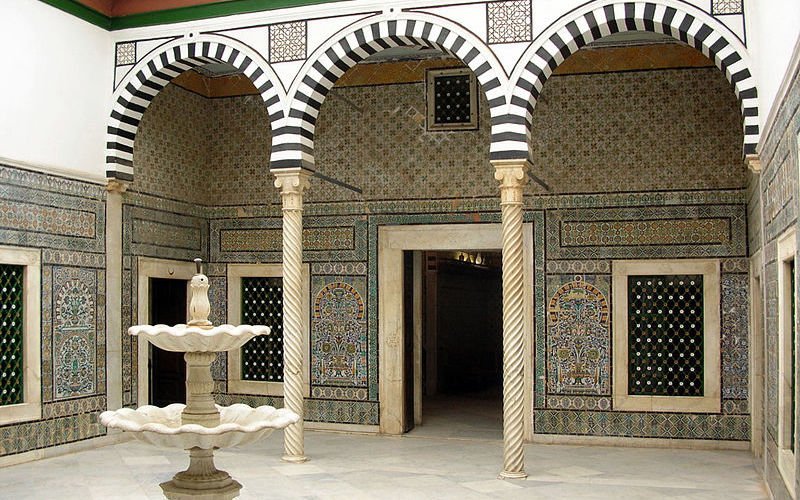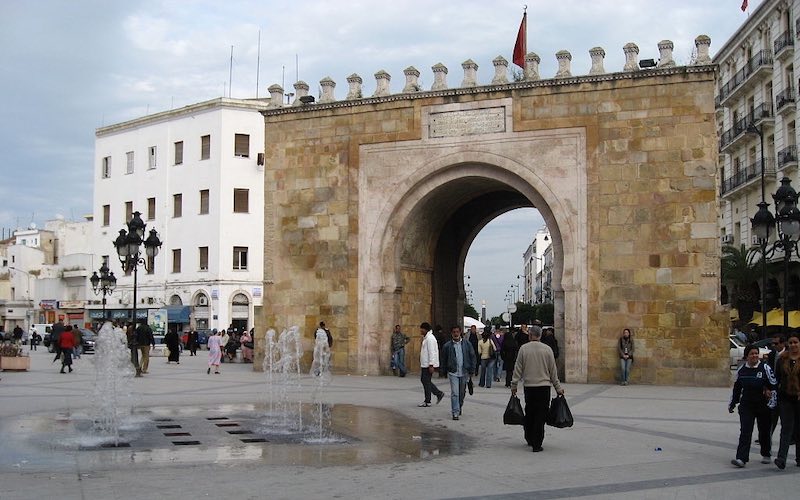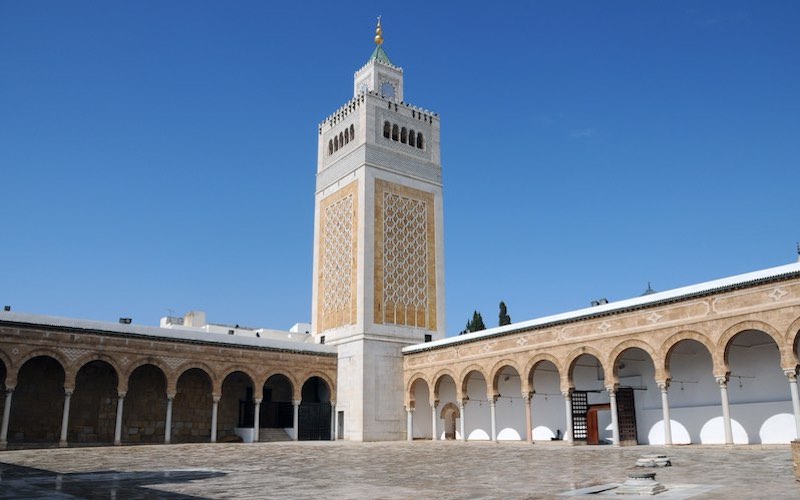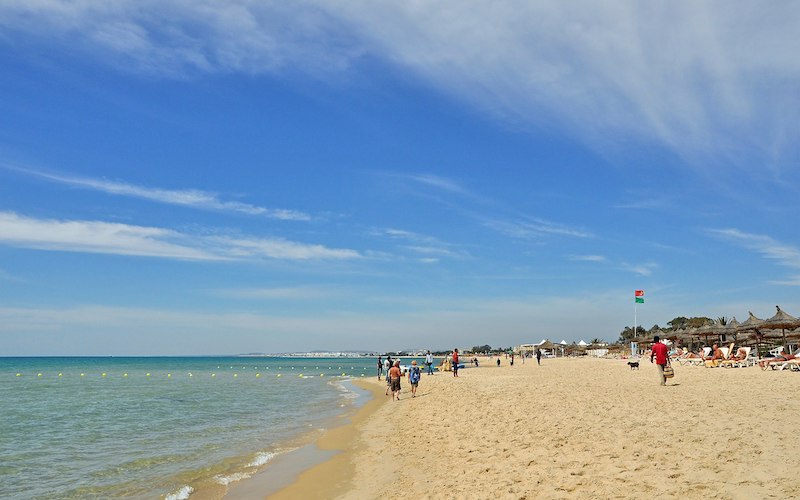Tunis, the capital of Tunisia, is a city rich in history and culture. From ancient ruins to vibrant markets and delicious cuisine, there is always something to see and do in Tunis. A weekend in Tunis is the perfect opportunity to explore the city and experience all that it has to offer. In this travel blog, I will take you on a journey through Tunis, discovering the city’s fascinating history and vibrant culture. You will visit some of Tunis’s most popular attractions, such as the ancient ruins of Carthage (my favourite thing about Tunis) and the stunning Bardo Museum. You will also take a stroll through the bustling markets of the Medina and sample some of Tunis’s delicious local cuisine. So, join me as I help you to discover the charms of Tunis on a weekend getaway.
Getting there and away – Tunis International Airport
The main airport serving Tunis, the capital of Tunisia, is Tunis-Carthage International Airport (IATA code: TUN). Tunis-Carthage International Airport is located about 8 kilometers (5 miles) from the city center of Tunis and is the main hub for Tunisair, the national airline of Tunisia. The airport serves a number of international destinations and is well-connected to the city centre by various forms of public transportation, including buses, taxis, and private car services. It’s just a 20 minute drive from Tunis airport to Tunis Medina.
Due to the limited direct flights to Tunis from UK, another viable option is to do what I did and fly direct from UK to Hammamet. Flights go to Enfidha Hammamet direct from:
- London Gatwick
- London Luton
- Bristol
- Cardiff
- Birmingham
- East Midlands
- Manchester (Easyjet)
- Newcastle
- Glasgow International
You can then take a transfer from Enfidha Hammamet to Tunis which will only take around 50 minutes. In my experience, there were a lot of crazy drivers and rip off taxis in Tunis, and so it may be a good and comfortable option to book yourself a transfer from the airport to your hotel.
When to travel to Tunis
Tunis has a Mediterranean climate, with hot, dry summers and mild, wet winters. The summer months (June to September) are the hottest and driest, with temperatures reaching up to 35°C (95°F) or more. The winter months (December to February) are milder and wetter, with temperatures ranging from around 10°C (50°F) to 20°C (68°F).
Tunis is a popular tourist destination, and the city can get quite crowded during the peak tourist season, which runs from June to September. The port is a stop off for many cruise ships. If you prefer to avoid crowds, you may want to consider visiting during the shoulder season (April to May or October to November) when the weather is still pleasant and the city is less crowded.
Tunis is home to a number of events and festivals throughout the year, including the Carthage International Festival, which takes place in July, and the Tunis International Book Fair, which takes place in December. If you are interested in attending a specific event or festival, you should plan your trip accordingly.
Also, as Tunisia is a Muslim country, consider whether or not you want to be there during Ramadan which takes place around March-April. Because it works on the lunar calendar, Ramadan tends to shift forward by 10 days every year. Tourists/non-Muslims are not expected to fast. However, you should avoid drinking alcohol during Ramadan and avoid eating or smoking in public areas during this time (from dawn till dusk).
Where to stay for your Weekend in Tunis
If you are looking for a mid-range hotel then go for the Ibis or Hotel Carlton. If you are looking for something more luxurious then I recommend Dar El Jeld Hotel and Spa. It’s a five star hotel with a concierge service and an in-house hammam. Stay near to the Medina, but not within the Medina as it can be an unsafe place at night.
How to Spend a Weekend in Tunis
Try to spend a full weekend in Tunis – arrive on a Friday night ready for a full day on Saturday and a full day on Sunday. Then fly home on the Monday morning if possible. This will give you one full day in Tunis to explore the Mosque, Kasbah and Museums and a second full day to explore the Roman ruins of Carthage.
Weekend in Tunis – Day 1 – Tunis
On your first morning in Tunis, head straight to the world famous Bardo Museum. Then you can spend the afternoon exploring the Mosque, Medina and main streets of the city. The Bardo museum is a little further away and so you should expect to take a cab (just 20 minutes) to the Zitouna Mosque.
As many people visit Tunis for a day on the cruise ships, they follow the main walking route from Place du 14 Janvier (14th January Square) to Zitouna Mosque, and so it is better for you to do the main walking route backwards(Zitouna Mosque to January Square). It is possible to do this route independently as a self guided walking tour, but you can also book a guide for the day in Tunis if you feel more comfortable.
Bardo Museum
Visit the Bardo Museum: This museum is located in a former palace and is home to one of the finest collections of Roman mosaics in the world. The museum also has a collection of Islamic art and other artifacts from Tunisian history. Arrive at 9am at the Bardo museum to see it first thing and then take a cab to Zitouna Mosque or the Medina.
If you would like to book a guided tour of the Bardo museum you can book it in advance online here. Prices start at €45 for an hour and a half.

Travel Tip: The Bardo Museum was closed on Mondays at the last time of checking.
Tunis Medina
The medina is the old city of Tunis, and it is a great place to explore on foot. The winding streets are filled with shops, markets, and restaurants, and it is also place to find souvenirs and try local food. It’s a great place to go souvenir shopping, but you will need to barter! It is common for the market sellers and shop owners to push things at 4 X the usual price – in some cases even 10 X!
If you are wanting to avoid too much attention from sellers then adopt conservative dress and women may choose to wear a headscarf. Women should avoid short skirts and also considering their having up and covered (especially if it’s blond!) Wearing sunglasses will mean less attention because there is less eye contact.
Keep your belongings close and secure as pick pockets have been reported inside the Tunis Medina. Some tourists have even reported having chains stolen from around their neck. Wear and carry minimal expensive belongings and keep your wits about you. Saying that, don’t let this put you off exploring the Medina. It is an exciting cultural experience and shouldn’t be missed.

Travel Tip: Avoid engaging in men who approach you in the Medina telling you that you are going the wrong way, or offering to help – they are unofficial guides and will try to scam money out of you. Avoid being in the Medina alone after dark – it is poorly lit and can be dangerous (muggings have bee reported).
Al-Zaytuna Mosque
Visit the Mosque of Al-Zaytuna. This beautiful mosque is located in the heart of the medina and is built in a similar style to the great Kairouan Mosque. Al-Zaytuna mosque dates back to the 8th Century and utilised over 200 Roman pillars from Carthage in its construction. Only Muslims may enter inside the Mosque, but you will be able to view it from the outside as a non-Muslim tourist and you can also view the courtyard from the terrace of the Panorama Medina Cafe.

Travel Tip: Most shops will allow you to view the Mosque from their roof terraced for free – you do not need to pay for this privilege (although some con-artists may try to take you and charge you!)
Bab el Bahr
Next walk to Bab el Bahr, commonly know as Porte de France (the French Gate) following colonial times. The gate was built during the reign of al-Nasir (1062–88 AD). It marks the separation between the old city and the modern city of Tunis.
Place de l’Independance (Independence Square)
You will walk from Bab el Bahr to Place de l’Independance (Independence Square) – the name was given to the square when Tunisia gained independence from France in 1956. Here you will find some famous landmarks including the French Embassy, the Cathedral of St. Vincent de Paul at Independence Square and the Ibn Khaldoun statue (a famous Tunisian philosopher). This is also where you can find the ‘I love Tunis’ sign for photo opportunities.
Cathédrale Saint-Vincent-de-Paul (St. Vincent de Paul Cathedral)
The Cathédrale Saint-Vincent-de-Paul, also known as St. Vincent de Paul Cathedral, is a Catholic cathedral located in Tunis, Tunisia. It is one of the largest and most important churches in the city, and it is named after St. Vincent de Paul, a French priest who was known for his work with the poor and disadvantaged.
The cathedral was built in the 19th century and is known for its beautiful Neo-Gothic architecture. It has a large central nave, as well as several side chapels and a crypt. The exterior of the cathedral features stone carvings and stained glass windows, and the interior is decorated with intricate frescoes and artwork.
Visitors can take guided tours of the cathedral, which provide an opportunity to learn more about its history and architecture.
Avenue Habib Bourguiba and Place du 14 Janvier (January Square)
Next, take walk along Avenue Habib Bourguiba. This street is the main thoroughfare of Tunis and is home to a number of important landmarks, including the National Theater. You will end up at 14 January Square which is the square that was named in honour of Mohamed Bouazizi ( market seller) who set himself on fire to protest against mistreatment. This was the catalyst of the Arab Spring, a series of protests across the Middle East in countries including Egypt, Bahrain, Libia and Syria.
Try some Local Cuisine
On your first evening in Tunis it is time to try some of the local cuisine. Tunisian cuisine is a blend of African, Arabic, and Mediterranean flavours, and there are many delicious dishes to try. Some popular dishes include couscous, shakshuka, and brik.
Weekend in Tunis – Day 2 – Exploring Carthage
On your second day, it’s time to get up early to explore the Roman Ruins of Carthage. Carthage is one of the most amazing things to do in Tunisia, especially if you are interested in history. So first, let’s take a look at the history of this ancient city that you are about to explore.
Introduction to the Ancient City of Carthage
The ancient city of Carthage was founded by the Phoenicians in the 9th century BCE and was an important centre of trade and commerce in the ancient world. Carthage was known for its wealth, its naval power, and its sophisticated culture, and it was one of the most prosperous cities of the ancient world.
Carthage was located at the crossroads of several major trade routes and was a major hub for trade in the Mediterranean region. The city was known for its production of textiles, metals, and other goods, and it was an important center of industry and innovation. The city was also home to a number of temples, theaters, and other public buildings, and it was a center of learning and scholarship.
Carthage was conquered by the Romans in the 2nd century BCE and became a part of the Roman Empire. The city was destroyed by the Romans in 146 BCE, but it was later rebuilt and continued to thrive as a center of trade and commerce. Today, the ruins of Carthage are a popular tourist destination and a testament to the city’s rich history and cultural heritage.
Planning your visit to Carthage Roman Ruins
Most of the Carthage ruins and museums are open from 9am-5pm and so it is a good idea to get to one of the main archaeological sites (such as the thermal baths or amphitheatre) first thing. Although some of the sites are walkable it can be a good idea to hire a driver as a guide to take you between the sites by car to make it easier. I would especially recommend getting a cab if it is a hot day as the walking between can dehydrate you in the Tunisian heat. When visiting Carthage, you should purchase the all-inclusive ticket for all of the attractions, which works out cheaper than buying individual tickets at each of the separate sites.
Exploring Carthage – AM
In the morning you will have plenty of time to explore the Roman ruins of Carthage including the Baths of Antoninus, the Amphitheatre of Carthage, Tophet de Carthage and Maison Romaine.
Baths of Antoninus
The Baths of Antoninus were a large Roman public bath complex in Carthage, Tunisia. They were built in the 2nd century AD, during the reign of the Roman Emperor Antoninus Pius, and were one of the largest and most elaborate baths in the Roman world. The complex covered an area of more than 16 acres and could accommodate up to 1,600 people at a time. It included a range of facilities, such as cold, warm, and hot baths, a gymnasium, a library, and gardens. The baths were a central part of Roman daily life, serving not only as a place for hygiene and relaxation, but also as a social hub where people could meet, exercise, and engage in leisure activities.
Amphitheatre of Carthage
The Amphitheatre of Carthage, also known as the Hippodrome of Carthage, was a large Roman amphitheatre located in the city of Carthage, Tunisia. It was built in the 2nd century AD, during the reign of the Roman Emperor Antoninus Pius, and could hold up to 50,000 spectators. The amphitheatre was used for a variety of entertainment events, including gladiator battles, animal fights, and chariot races. It was also a popular venue for public gatherings, such as political rallies and religious ceremonies. The Amphitheatre of Carthage was a major landmark in the city and played a central role in the cultural and social life of the community.
Tophet de Carthage
The Tophet was a sacred area where the Phoenicians, who founded Carthage, practiced child sacrifice as part of their religion. It is believed that the Tophet was in use from the 8th century BC until the 2nd century BC. The site was discovered in the 19th century and has been the subject of much historical and archaeological research. The Tophet consists of a number of burial grounds containing the remains of infants and animals, as well as artifacts and inscriptions related to the Phoenician religion. The Tophet of Carthage is a significant historical and cultural site and is considered an important part of the heritage of Carthage and Tunisia.
Maison Romaine
The Roman House in Carthage, also known as the Domus Romaine or Maison Romaine, is a well-preserved Roman villa located in the ancient city of Carthage, Tunisia. The villa dates back to the 2nd century AD and is a prime example of Roman domestic architecture. It was likely the home of a wealthy Roman family and features a range of luxurious amenities, such as a courtyard, a garden, a pool, and an underground heating system. The Roman House is a significant historical site and is very beautiful – nice flowers and greenery can be seen in the spring and summer months.
Exploring Carthage – PM
Your afternoon on the second day will be spent visiting Saint Louis Cathedral and the Byrsa Hill Museum followed by the Carthage National Museum.
Saint Louis Cathedral
Saint Louis Cathedral located on Byrsa Hill in Tunis, Tunisia, it is a Roman Catholic cathedral located in the heart of the city, on a hill overlooking the old city of Tunis and the Mediterranean Sea. The cathedral is named after St. Louis, the patron saint of Tunis, and it is one of the largest and most important churches in the city.
The cathedral was built in the 19th century and is known for its Neo-Gothic architecture. It has a large central nave, as well as several side chapels and a crypt. The exterior of the cathedral features stone carvings and stained glass windows, and the interior is decorated with intricate frescoes and artwork.
Byrsa Hill Ruins and Museum
Next, head to the Byrsa Hill Museum (just a short walk from the Archaeological Site but easier to go to in a car!). The museum is home to a collection of artefacts from the Phoenician and Punic periods, and it offers a great overview of the history of Carthage. Byrsa Hill also contains a number of remains from the original Punic city – you will have an excellent view of Carthaginian residential neighbourhood, complete with ancient houses and a series of Punic tombs. This location is an excellent photo opportunity for the views over Tunis and Carthage.
Carthage National Museum
In the afternoon, visit the Carthage National Museum, which is located in a beautiful 19th-century palace. The museum is home to a collection of artefacts from the ancient city of Carthage, as well as from other periods of Tunisian history.
Walking along the Beaches of Carthage – Sidi Bou Said
Finish your day by taking a stroll along the beach and enjoying the sunset. The beaches of Carthage are popular spots for swimming and relaxing, and they offer beautiful views of the Mediterranean Sea. Sidi Bou Said offers one of the most beautiful views across the Tunis coastline. The view is complemented by the beautiful white and blue houses and domes of Sidi Bou Said.

Overall, it is possible to see the highlights of Carthage in one day, but it will require some careful planning and a bit of hustle to fit everything in. It’s a good idea to start your day early and take breaks as needed to rest and refuel.
Tips for Spending a weekend in Tunis as a Tourist
- For a good weekend in Tunis, spend one day exploring the Old Town and city centre landmarks and a second day exploring the Roman Ruins of Carthage.
- Booking a guide for Carthage is well worth it, but make sure that you get a legitimate one.
- Purchase the all-inclusive ticket for the ruins of Carthage which works out cheaper than paying at each individual site.
- Avoid the taxi touts as they will massively overcharge you.
- Dress conservatively – especially women, to avoid unwanted attention.
- Avoid men who approach you inside the Medina and keep your belongings close.
Further Reading on Tunisia
If you enjoyed this guide to how to spend a weekend in Tunis, you might also like like to read: My Holiday to Tunisia – The Good, the Bad and the Ugly. If you have time while you are in Tunisia I would also recommend that you visit El Djem Roman amphitheatre and Kairouan Great Mosque.
Have a fantastic weekend in Tunis, and I would love to hear about your experiences – please comment on my blog below.
